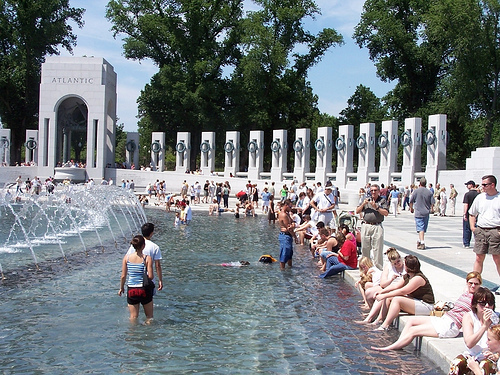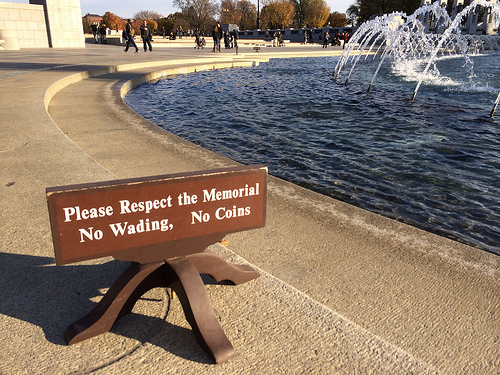Go ahead, wade in the memorial
Wading in the World War II memorial is emphatically not allowed. Solemnity is the officially preferred emotion. But the memorial’s buoyant design inherently invokes liveliness, and strict rules violate the spirit of the war against fascism.
Every summer when Washington heats up, tourists find a respite from the heat at the World War II memorial. Thousands dip their feet in, and a few inevitably wade towards the middle.
Until a National Park Service ranger chastises them for disrespecting the memorial, and makes them return to dry land. Or until local media scolds them back to shore.
The rangers and media are well-intentioned, but treating the World War II memorial with a solemnity not reflected in the design does little to inspire respect.
The memorial doesn’t have a solemn design
Truthfully, the World War II memorial doesn’t function well as a somber space. Its lively fast-moving fountains and bright, sun-filled plaza bring it to life.
Kirk Savage puts it well in his book, Monument Wars: Washington, DC, the National Mall, and the Transformation of the Memorial Landscape:
The World War II Memorial is decidedly not a psychological space, not a space for reflection and reckoning. The roar of the fountains, and the inscriptions trumpet their messages of determination and rectitude…This is a space not for internal reckoning but for acclimation, pure and simple.
The central fountain doesn’t inspire quiet reflection. It’s an active, bustling space, full of people enjoying their day every bit as much as they contemplate America’s role in World War II.
By intent or happenstance, the design inspires people to move about, to fill what would otherwise be stark emptiness with their activity.
Years ago when I was in the Navy, my captain had a saying: “Every sign is a failure of leadership.” For example, if you need a sign saying “no smoking,” it’s because you didn’t properly train your sailors not to smoke in that space.
That axiom doesn’t always hold outside the closed ecosystem of a ship, but I think it pertains here. If we need a sign saying “no wading,” it’s because the design has failed to discourage wading.
If you need several such signs, and rangers need to constantly enforce it, I’d say that far from discouraging wading, the memorial’s design implicitly encourages it.
Contrast the WWII memorial with the one for Vietnam
Contrast it with the Vietnam Veterans memorial, where most visitors are naturally somber, and the effect of design becomes clear.
I’m a tour guide. When visiting the memorials with my student groups, I take a moment to warn them about appropriate behavior. But at the Vietnam memorial, my efforts are generally superfluous.
The memorial’s very design imposes it’s own mores. Few of my students know more than the most cursory details of the Vietnam War, but when they descend into the memorial, with its merciless rise of row after row of names, it makes an impression on even the most jaded eighth grader.
The space inspires a natural quiet reflection.
The World War II Memorial very much does not. Rather, it celebrates life. And that is OK.
Enforced solemnity violates the spirit of the war
To me, the natural enthusiasm and activity imbued within the World War II memorial evokes the spirit of relief and jubilation of the end of the war.
A hard fought war, to defeat what may have been the most concentrated evil political system ever to be seen on this planet, ended with tremendous sacrifice and loss, but with victory.
It is right that we honor the sacrifices of the World War II generation with the somber Freedom Wall, and its 4048 gold stars, each representing 100 Americans killed in the war. But just as that wall is only part of the memorial, so should that emotion be only part of our interaction with it.
No one scolded the people celebrating VJ Day in Times Square at the end of the war. We need not scold tourists today. There’s room for unbridled enthusiasm, for joy, for relief at the end of deep pain, just as there is a place for solemnity.
I can’t claim to speak for the myriad of reasons why millions of individual Americans fought this war. After all, I don’t appreciate others characterizing my military service to suit their own ends. But ultimately World War II was about freedom, so let’s celebrate that, in all the chaotic and uncontrollable ways it might manifest itself.


